1 科技翻译
- 格式:ppt
- 大小:114.50 KB
- 文档页数:83
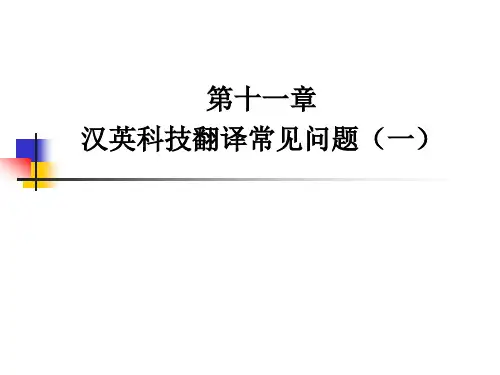
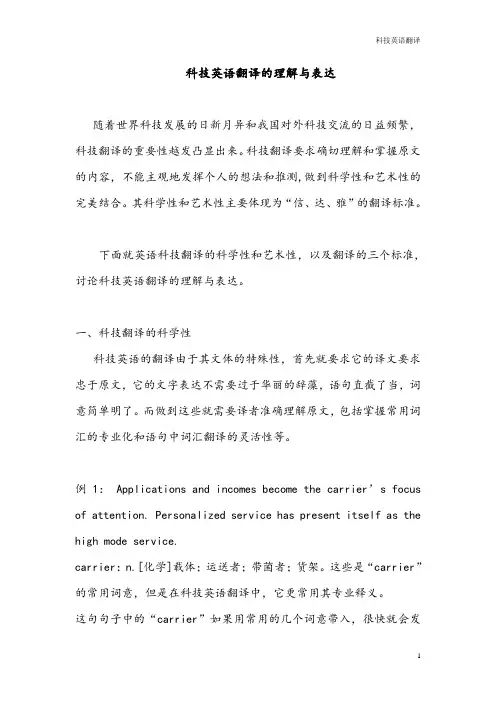
科技英语翻译的理解与表达随着世界科技发展的日新月异和我国对外科技交流的日益频繁,科技翻译的重要性越发凸显出来。
科技翻译要求确切理解和掌握原文的内容,不能主观地发挥个人的想法和推测,做到科学性和艺术性的完美结合。
其科学性和艺术性主要体现为“信、达、雅”的翻译标准。
下面就英语科技翻译的科学性和艺术性,以及翻译的三个标准,讨论科技英语翻译的理解与表达。
一、科技翻译的科学性科技英语的翻译由于其文体的特殊性,首先就要求它的译文要求忠于原文,它的文字表达不需要过于华丽的辞藻,语句直截了当,词意简单明了。
而做到这些就需要译者准确理解原文,包括掌握常用词汇的专业化和语句中词汇翻译的灵活性等。
例1:Applications and incomes become the carrier’s focus of attention. Personalized service has present itself as the high mode service.carrier:n.[化学]载体;运送者;带菌者;货架。
这些是“carrier”的常用词意,但是在科技英语翻译中,它更常用其专业释义。
这句句子中的“carrier”如果用常用的几个词意带入,很快就会发现句子是不通顺的,根据前后文则可以猜测它的词意应该与经济体有关。
实际上,这里“carrier”是“运营商”的意思。
译文:运营商的关注焦点已从技术转向了应用、服务和收益。
作为信息服务的高级形态,个性化服务开始逐步走上了前台。
例2:Ozone pollution is a concern during the summer months because strong sunlight and hot weather result in harmful ozone concentrations in the air we breathe.concern:vt.涉及,关系到;使担心。
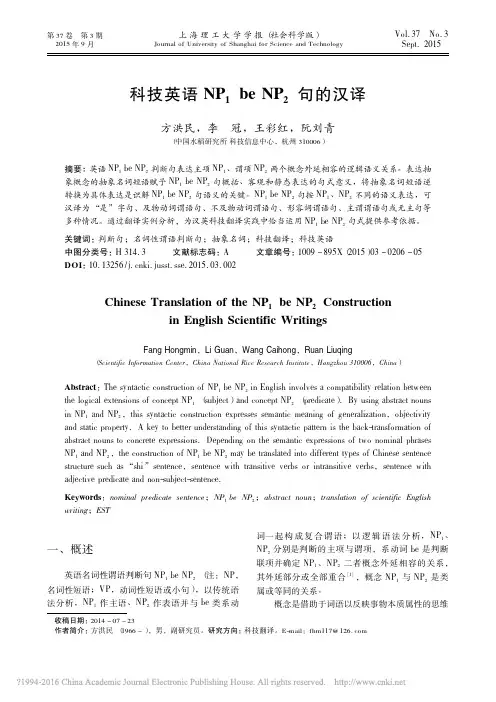
第37卷第3期2015年9月上海理工大学学报(社会科学版)Journal of University of Shanghai for Science and TechnologyVol.37No.3Sept.2015收稿日期:2014-07-23作者简介:方洪民(1966-),男,副研究员。
研究方向:科技翻译。
E-mail :fhm117@126.com 科技英语NP 1be NP 2句的汉译方洪民,李冠,王彩红,阮刘青(中国水稻研究所科技信息中心,杭州310006)摘要:英语NP 1be NP 2判断句表达主项NP 1、谓项NP 2两个概念外延相容的逻辑语义关系。
表达抽象概念的抽象名词短语赋予NP 1be NP 2句概括、客观和静态表达的句式意义,将抽象名词短语逆转换为具体表达是识解NP 1be NP 2句语义的关键。
NP 1be NP 2句按NP 1、NP 2不同的语义表达,可汉译为“是”字句、及物动词谓语句、不及物动词谓语句、形容词谓语句、主谓谓语句或无主句等多种情况。
通过翻译实例分析,为汉英科技翻译实践中恰当运用NP 1be NP 2句式提供参考依据。
关键词:判断句;名词性谓语判断句;抽象名词;科技翻译;科技英语中图分类号:H 314.3文献标志码:A 文章编号:1009-895X (2015)03-0206-05DOI :10.13256/j.cnki.jusst.sse.2015.03.002Chinese Translation of the NP 1be NP 2Constructionin English Scientific WritingsFang Hongmin ,Li Guan ,Wang Caihong ,Ruan Liuqing(Scientific Information Center ,China National Rice Research Institute ,Hangzhou 310006,China )Abstract :The syntactic construction of NP 1be NP 2in English involves a compatibility relation between the logical extensions of concept NP 1(subject )and concept NP 2(predicate ).By using abstract nouns in NP 1and NP 2,this syntactic construction expresses semantic meaning of generalization ,objectivity and static property.A key to better understanding of this syntactic pattern is the back-transformation of abstract nouns to concrete expressions.Depending on the semantic expressions of two nominal phrases NP 1and NP 2,the construction of NP 1be NP 2may be translated into different types of Chinese sentence structure such as “shi ”sentence ,sentence with transitive verbs or intransitive verbs ,sentence with adjective predicate and non-subject-sentence.Keywords :nominal predicate sentence ;NP 1be NP 2;abstract noun ;translation of scientific English writing ;EST一、概述英语名词性谓语判断句NP 1be NP 2(注:NP ,名词性短语;VP ,动词性短语或小句),以传统语法分析,NP 1作主语、NP 2作表语并与be 类系动词一起构成复合谓语;以逻辑语法分析,NP 1、NP 2分别是判断的主项与谓项,系动词be 是判断联项并确定NP 1、NP 2二者概念外延相容的关系,其外延部分或全部重合[1],概念NP 1与NP 2是类属或等同的关系。
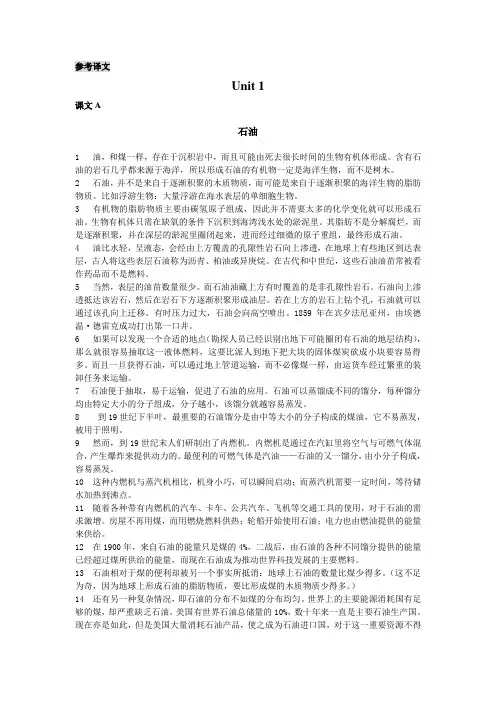
参考译文Unit 1课文A石油1油,和煤一样,存在于沉积岩中,而且可能由死去很长时间的生物有机体形成。
含有石油的岩石几乎都来源于海洋,所以形成石油的有机物一定是海洋生物,而不是树木。
2 石油,并不是来自于逐渐积聚的木质物质,而可能是来自于逐渐积聚的海洋生物的脂肪物质。
比如浮游生物:大量浮游在海水表层的单细胞生物。
3 有机物的脂肪物质主要由碳氢原子组成,因此并不需要太多的化学变化就可以形成石油。
生物有机体只需在缺氧的条件下沉积到海湾浅水处的淤泥里。
其脂肪不是分解腐烂,而是逐渐积聚,并在深层的淤泥里圈闭起来,进而经过细微的原子重组,最终形成石油。
4 油比水轻,呈液态,会经由上方覆盖的孔隙性岩石向上渗透,在地球上有些地区到达表层,古人将这些表层石油称为沥青、柏油或异庚烷。
在古代和中世纪,这些石油油苗常被看作药品而不是燃料。
5 当然,表层的油苗数量很少。
而石油油藏上方有时覆盖的是非孔隙性岩石。
石油向上渗透抵达该岩石,然后在岩石下方逐渐积聚形成油层。
若在上方的岩石上钻个孔,石油就可以通过该孔向上迁移。
有时压力过大,石油会向高空喷出。
1859年在宾夕法尼亚州,由埃德温·德雷克成功打出第一口井。
6 如果可以发现一个合适的地点(勘探人员已经识别出地下可能圈闭有石油的地层结构),那么就很容易抽取这一液体燃料,这要比派人到地下把大块的固体煤炭砍成小块要容易得多。
而且一旦获得石油,可以通过地上管道运输,而不必像煤一样,由运货车经过繁重的装卸任务来运输。
7 石油便于抽取,易于运输,促进了石油的应用。
石油可以蒸馏成不同的馏分,每种馏分均由特定大小的分子组成,分子越小,该馏分就越容易蒸发。
8 到19世纪下半叶,最重要的石油馏分是由中等大小的分子构成的煤油,它不易蒸发,被用于照明。
9 然而,到19世纪末人们研制出了内燃机。
内燃机是通过在汽缸里将空气与可燃气体混合,产生爆炸来提供动力的。
最便利的可燃气体是汽油——石油的又一馏分,由小分子构成,容易蒸发。
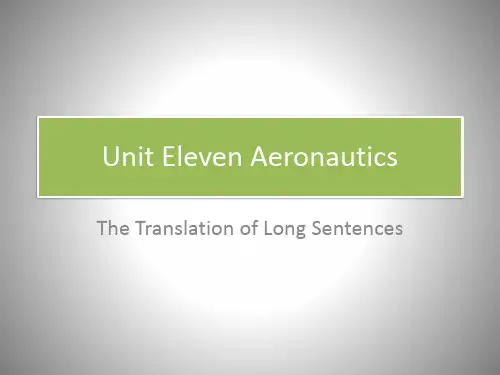

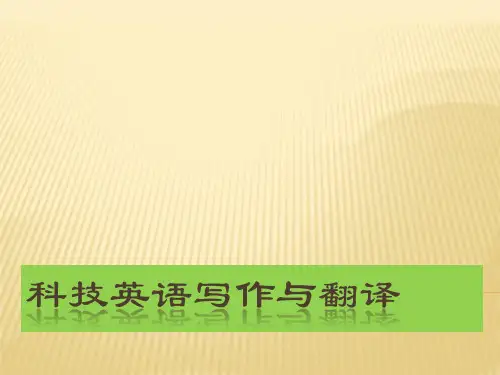
![中国翻译史[1]](https://uimg.taocdn.com/68a5cfc4da38376baf1faec8.webp)
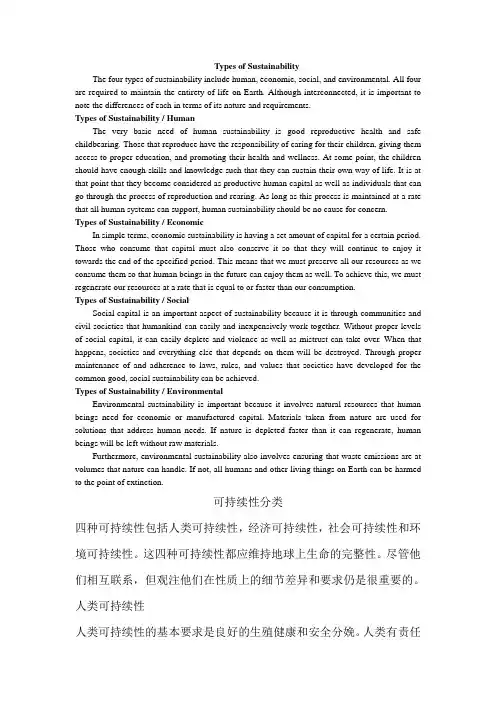
Types of SustainabilityThe four types of sustainability include human, economic, social, and environmental. All four are required to maintain the entirety of life on Earth. Although interconnected, it is important to note the differences of each in terms of its nature and requirements.Types of Sustainability / HumanThe very basic need of human sustainability is good reproductive health and safe childbearing. Those that reproduce have the responsibility of caring for their children, giving them access to proper education, and promoting their health and wellness. At some point, the children should have enough skills and knowledge such that they can sustain their own way of life. It is at that point that they become considered as productive human capital as well as individuals that can go through the process of reproduction and rearing. As long as this process is maintained at a rate that all human systems can support, human sustainability should be no cause for concern.Types of Sustainability / EconomicIn simple terms, economic sustainability is having a set amount of capital for a certain period. Those who consume that capital must also conserve it so that they will continue to enjoy it towards the end of the specified period. This means that we must preserve all our resources as we consume them so that human beings in the future can enjoy them as well. To achieve this, we must regenerate our resources at a rate that is equal to or faster than our consumption.Types of Sustainability / SocialSocial capital is an important aspect of sustainability because it is through communities and civil societies that humankind can easily and inexpensively work together. Without proper levels of social capital, it can easily deplete and violence as well as mistrust can take over. When that happens, societies and everything else that depends on them will be destroyed. Through proper maintenance of and adherence to laws, rules, and values that societies have developed for the common good, social sustainability can be achieved.Types of Sustainability / EnvironmentalEnvironmental sustainability is important because it involves natural resources that human beings need for economic or manufactured capital. Materials taken from nature are used for solutions that address human needs. If nature is depleted faster than it can regenerate, human beings will be left without raw materials.Furthermore, environmental sustainability also involves ensuring that waste emissions are at volumes that nature can handle. If not, all humans and other living things on Earth can be harmed to the point of extinction.可持续性分类四种可持续性包括人类可持续性,经济可持续性,社会可持续性和环境可持续性。
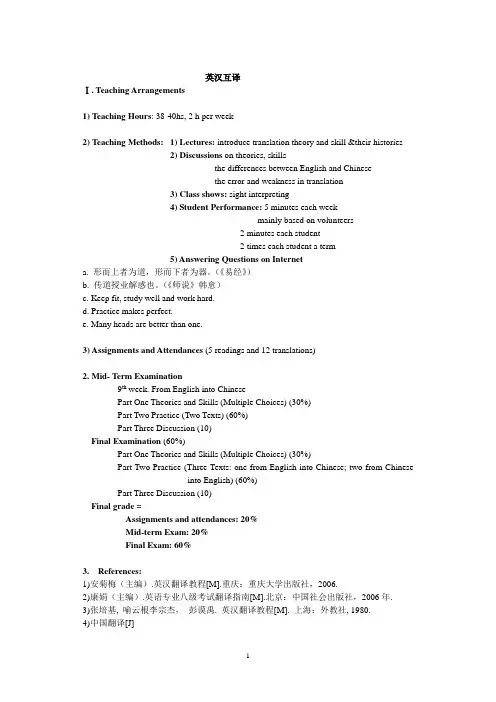
英汉互译Ⅰ. Teaching Arrangements1) Teaching Hours: 38-40hs, 2 h per week2) Teaching Methods: 1) Lectures: introduce translation theory and skill &their histories2) Discussions on theories, skillsthe differences between English and Chinesethe error and weakness in translation3) Class shows: sight interpreting4) Student Performance: 5 minutes each weekmainly based on volunteers2 minutes each student2 times each student a term5) Answering Questions on Interneta. 形而上者为道,形而下者为器。
(《易经》)b. 传道授业解惑也。
(《师说》韩愈)c. Keep fit, study well and work hard.d. Practice makes perfect.e. Many heads are better than one.3) Assignments and Attendances (5 readings and 12 translations)2. Mid- Term Examination9th week. From English into ChinesePart One Theories and Skills (Multiple Choices) (30%)Part Two Practice (Two Texts) (60%)Part Three Discussion (10)Final Examination (60%)Part One Theories and Skills (Multiple Choices) (30%)Part Two Practice (Three Texts: one from English into Chinese; two from Chineseinto English) (60%)Part Three Discussion (10)Final grade =Assignments and attendances: 20%Mid-term Exam: 20%Final Exam: 60%3. References:1)安菊梅(主编).英汉翻译教程[M].重庆:重庆大学出版社,2006.2)康娟(主编).英语专业八级考试翻译指南[M].北京:中国社会出版社,2006年.3)张培基, 喻云根李宗杰,彭谟禹. 英汉翻译教程[M]. 上海:外教社, 1980.4)中国翻译[J]5)陆谷孙(主编). 新编英汉大词典[Z].上海:上海译文出版社,1996.6)谭卫国,蔡金龙(主编).新编英汉互译教程[M].上海:华东理工大学出版社,2005.7)阎佩斯[M].英汉与汉英翻译教学论[M].北京:高等教育出版社,2005.8)英语学习[J]9)英语沙龙[J]10)上海科技翻译[J]任课翻译成果Lecture One1. IntroductionTranslation means the conversion of an expression into another language. To say plainly it is an art to reproduce the exact idea of the author by means of a language different from the original. From the above definition of translation we know that the original thought of the expression must be kept as exactly as possible. Nothing should be added to or translator taken away from the original work. The duty of the translator is simply to change the vocabulary not the thought. In translation therefore, there are two essential elements: accuracy andexpressiveness.Accuracy is the first requisite of translation. The translator must stick to the author’s idea. Words selected and construction sentences constructed must be of such nature as will convey the exact original thought. Expressiveness is to make the translation readily understood. In other words, the translator must express his author’s idea as clearly and as forcibly as he can by the medium he employs. Accuracy is to make the thought definite and exact; while expressiveness is to make the translation, vivid and attractive.2. Theories1)翻译简史简史中国的翻译历史简单分为四个主要阶段。

《科技英语翻译》课程练习一《科技英语翻译》课程练习一答案一、翻译以下句子,注意其中定语成分的处理1) For two forces to cancel, they must act on the same object.译文:为了使两个力能相互抵消,它们必须作用在同一物体上。
2) This charged particle is small enough to be considered asa point.译文:这个带电粒子小到可以被看成一个点。
3) Doubling the volume means halving the pressure.译文:使体积加倍,意味着使压力减半。
4) On integrating this equation, we obtain a formula whereby the exponent of the cosine factor is unchanged.译文:对这个方程积分后,我们得到了一个公式,根据这个公式,余弦因子的指数并不改变。
5) The acceleration of a body is directly proportional to the force acting and is inversely proportionalto the mass of the body.译文:物体的加速度正比于作用力而反比于物体的质量。
6) The energy required to effect the successive accelerations and move an electron from one pointto another is called the electric potential difference.译文:为了引起不断的加速而使电子从一点运动到另一点所需的能量,称为该两点间的电位差。
二、翻译以下句子,注意翻译的标准1) The power plant is the heart of a ship.译文:动力装置是船舶的心脏。
《专业英语(制药工程)》【科技英语的常用句型和翻译技巧】一、概述1. 翻译的要求The Criteria of Translation:信、雅、达2. 科技英语词汇(上节课已经介绍)3. 科技英语句子的特点二、科技英语常用句型及翻译1. 被动语态1)被动语态的常用原因常用被动语态主要见于以下几个方面:①不必或无法说出主动者For a long time aluminum has been thought as an effective material for preventing metal corrosion.长期以来,铝被当作一种有效的防止金属腐蚀的材料。
►The book has already been translated into many languages.②强调行为对象,而非行为者,将行为对象作为句子的主语Three machines can be controlled by a single operation.三台机器能由一个操作者操纵。
►The work must be finished at once.③为了更好的联系上下文►They are going to build a library here next year. It is going to be build beside the classroom building.2)被动语句的翻译方法(1)仍译为被动句最常见的是在谓语前加上助词“被”,也可使用“受到,遭到,得到,叫,称,让,给,加以,为……所”等句式。
偶尔也可不加任何词直接译出。
We remember how air can be made into a liquid. If the liquid is warmed again, it “boiled”and turns back into a gas.我们记得是如何把空气制成液体的。
如果给这种液体重新加热,它“沸腾汽化”,就又还原成气体。